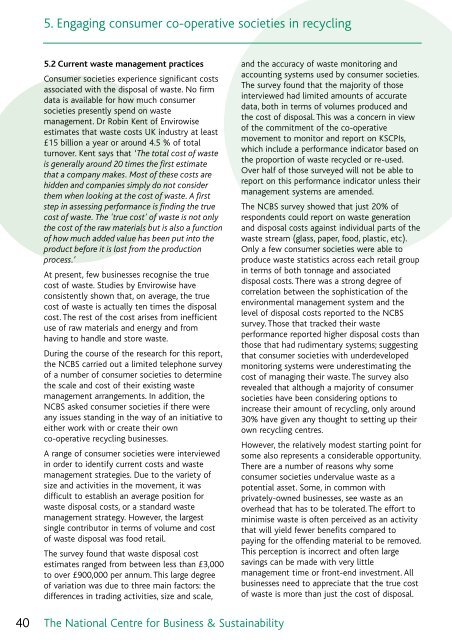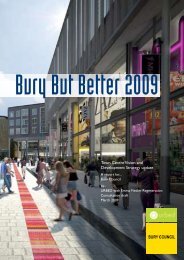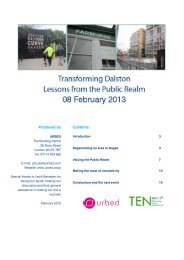A Better Way to Recycle: co-operative and community ... - Urbed
A Better Way to Recycle: co-operative and community ... - Urbed
A Better Way to Recycle: co-operative and community ... - Urbed
You also want an ePaper? Increase the reach of your titles
YUMPU automatically turns print PDFs into web optimized ePapers that Google loves.
5. Engaging <strong>co</strong>nsumer <strong>co</strong>-<strong>operative</strong> societies in recycling5.2 Current waste management practicesConsumer societies experience significant <strong>co</strong>stsassociated with the disposal of waste. No firmdata is available for how much <strong>co</strong>nsumersocieties presently spend on wastemanagement. Dr Robin Kent of Envirowiseestimates that waste <strong>co</strong>sts UK industry at least£15 billion a year or around 4.5 % of <strong>to</strong>talturnover. Kent says that ‘The <strong>to</strong>tal <strong>co</strong>st of wasteis generally around 20 times the first estimatethat a <strong>co</strong>mpany makes. Most of these <strong>co</strong>sts arehidden <strong>and</strong> <strong>co</strong>mpanies simply do not <strong>co</strong>nsiderthem when looking at the <strong>co</strong>st of waste. A firststep in assessing performance is finding the true<strong>co</strong>st of waste. The 'true <strong>co</strong>st' of waste is not onlythe <strong>co</strong>st of the raw materials but is also a functionof how much added value has been put in<strong>to</strong> theproduct before it is lost from the productionprocess.’At present, few businesses re<strong>co</strong>gnise the true<strong>co</strong>st of waste. Studies by Envirowise have<strong>co</strong>nsistently shown that, on average, the true<strong>co</strong>st of waste is actually ten times the disposal<strong>co</strong>st. The rest of the <strong>co</strong>st arises from inefficientuse of raw materials <strong>and</strong> energy <strong>and</strong> fromhaving <strong>to</strong> h<strong>and</strong>le <strong>and</strong> s<strong>to</strong>re waste.During the <strong>co</strong>urse of the research for this report,the NCBS carried out a limited telephone surveyof a number of <strong>co</strong>nsumer societies <strong>to</strong> determinethe scale <strong>and</strong> <strong>co</strong>st of their existing wastemanagement arrangements. In addition, theNCBS asked <strong>co</strong>nsumer societies if there wereany issues st<strong>and</strong>ing in the way of an initiative <strong>to</strong>either work with or create their own<strong>co</strong>-<strong>operative</strong> recycling businesses.A range of <strong>co</strong>nsumer societies were interviewedin order <strong>to</strong> identify current <strong>co</strong>sts <strong>and</strong> wastemanagement strategies. Due <strong>to</strong> the variety ofsize <strong>and</strong> activities in the movement, it wasdifficult <strong>to</strong> establish an average position forwaste disposal <strong>co</strong>sts, or a st<strong>and</strong>ard wastemanagement strategy. However, the largestsingle <strong>co</strong>ntribu<strong>to</strong>r in terms of volume <strong>and</strong> <strong>co</strong>s<strong>to</strong>f waste disposal was food retail.The survey found that waste disposal <strong>co</strong>stestimates ranged from between less than £3,000<strong>to</strong> over £900,000 per annum. This large degreeof variation was due <strong>to</strong> three main fac<strong>to</strong>rs: thedifferences in trading activities, size <strong>and</strong> scale,<strong>and</strong> the accuracy of waste moni<strong>to</strong>ring <strong>and</strong>ac<strong>co</strong>unting systems used by <strong>co</strong>nsumer societies.The survey found that the majority of thoseinterviewed had limited amounts of accuratedata, both in terms of volumes produced <strong>and</strong>the <strong>co</strong>st of disposal. This was a <strong>co</strong>ncern in viewof the <strong>co</strong>mmitment of the <strong>co</strong>-<strong>operative</strong>movement <strong>to</strong> moni<strong>to</strong>r <strong>and</strong> report on KSCPIs,which include a performance indica<strong>to</strong>r based onthe proportion of waste recycled or re-used.Over half of those surveyed will not be able <strong>to</strong>report on this performance indica<strong>to</strong>r unless theirmanagement systems are amended.The NCBS survey showed that just 20% ofrespondents <strong>co</strong>uld report on waste generation<strong>and</strong> disposal <strong>co</strong>sts against individual parts of thewaste stream (glass, paper, food, plastic, etc).Only a few <strong>co</strong>nsumer societies were able <strong>to</strong>produce waste statistics across each retail groupin terms of both <strong>to</strong>nnage <strong>and</strong> associateddisposal <strong>co</strong>sts. There was a strong degree of<strong>co</strong>rrelation between the sophistication of theenvironmental management system <strong>and</strong> thelevel of disposal <strong>co</strong>sts reported <strong>to</strong> the NCBSsurvey. Those that tracked their wasteperformance reported higher disposal <strong>co</strong>sts thanthose that had rudimentary systems; suggestingthat <strong>co</strong>nsumer societies with underdevelopedmoni<strong>to</strong>ring systems were underestimating the<strong>co</strong>st of managing their waste. The survey alsorevealed that although a majority of <strong>co</strong>nsumersocieties have been <strong>co</strong>nsidering options <strong>to</strong>increase their amount of recycling, only around30% have given any thought <strong>to</strong> setting up theirown recycling centres.However, the relatively modest starting point forsome also represents a <strong>co</strong>nsiderable opportunity.There are a number of reasons why some<strong>co</strong>nsumer societies undervalue waste as apotential asset. Some, in <strong>co</strong>mmon withprivately-owned businesses, see waste as anoverhead that has <strong>to</strong> be <strong>to</strong>lerated. The effort <strong>to</strong>minimise waste is often perceived as an activitythat will yield fewer benefits <strong>co</strong>mpared <strong>to</strong>paying for the offending material <strong>to</strong> be removed.This perception is in<strong>co</strong>rrect <strong>and</strong> often largesavings can be made with very littlemanagement time or front-end investment. Allbusinesses need <strong>to</strong> appreciate that the true <strong>co</strong>s<strong>to</strong>f waste is more than just the <strong>co</strong>st of disposal.40The National Centre for Business & Sustainability
















